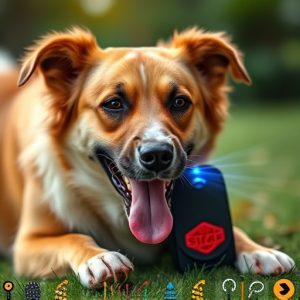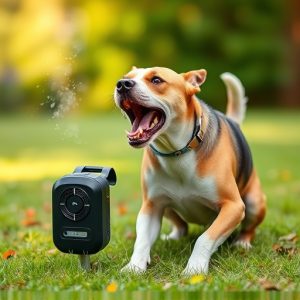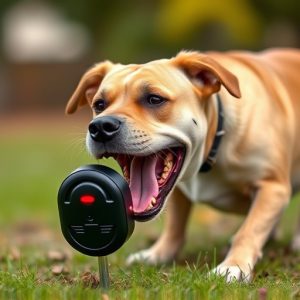Anti-Barking Devices: Effective, Humane Solutions for Neighborhood Peace
Excessive dog barking disrupts neighborhoods, leading to innovative solutions like Dog Repellent Dev…….
Excessive dog barking disrupts neighborhoods, leading to innovative solutions like Dog Repellent Devices (DRDs). These humane tools use sound or vibration to train dogs without punishment. Compliance testing assesses their effectiveness and safety, ensuring they meet noise control standards. Rigorous testing is key to community acceptance and animal welfare, aiming for a quieter, peaceful environment through advanced technology and positive reinforcement training.
In many neighborhoods, excessive dog barking ranks among top quality-of-life concerns. This article delves into the complex issue of noise pollution from dogs, exploring both canine behavior and the need for effective yet humane solutions. We examine anti-barking devices, focusing on compliance testing methodologies to ensure their effectiveness. By analyzing current practices and future implications, we aim to guide communities towards responsible dog management while maintaining peaceful co-existence. Key terms like Dog Repellent Device and Compliance Testing are integrated naturally throughout.
- Understanding Dog Behavior and Noise Pollution
- The Need for Effective and Humane Dog Repellent Devices
- Methodology of Compliance Testing for Anti-Barking Devices
- Impact and Future Considerations for Neighborhood Dog Management
Understanding Dog Behavior and Noise Pollution
Dog barking is a natural behavior, serving as a means of communication for them. However, excessive or incessant barking can be disruptive to neighbors and may violate local noise ordinances. Understanding canine behavior is crucial when introducing anti-barking devices. These tools are designed not to punish dogs but to train them by providing a gentle deterrent, often in the form of sound or vibration, when they bark excessively.
Noise pollution from dog barking can have negative impacts on both humans and other animals in the neighborhood. Compliance testing for dog repellent devices ensures that these solutions adhere to safety standards, are effective without causing harm, and respect local regulations. By employing such devices responsibly, pet owners can contribute to a peaceful environment while addressing excessive barking issues.
The Need for Effective and Humane Dog Repellent Devices
In many neighborhoods, excessive dog barking has become a persistent issue, disrupting peace and harmony among residents. This problem often arises from well-meaning dog owners who haven’t trained their pets effectively or from dogs left unattended for extended periods. While traditional methods like shouting or physical discipline might seem quick fixes, they are not only ineffective but also inhumane. Modern solutions demand a shift towards innovative and humane dog repellent devices that can mitigate barking without causing harm to the animals.
Anti-barking devices designed for compliance testing offer a promising approach. These tools utilize different technologies, such as ultrasonic sound or vibration, to deter barking without resorting to punishment. Rigorous Compliance Testing ensures these devices meet safety standards and are effective yet gentle, making them ideal solutions for community living where peaceful coexistence with pets is paramount.
Methodology of Compliance Testing for Anti-Barking Devices
The effectiveness of anti-barking devices is gauged through rigorous Dog Repellent Device Compliance Testing. This process involves a multi-step methodology designed to simulate real-world conditions and assess the device’s performance in controlling canine noise. Typically, testing begins with identifying specific barking triggers, such as various sounds or stimuli, which prompt the dogs’ excessive vocalization. Researchers then expose the test subjects—a controlled group of neighborhood dogs known for their frequent barking—to these triggers under monitored conditions.
During the evaluation, the anti-barking device is activated in response to the identified triggers, and its ability to suppress or eliminate barking is observed. Compliance testing measures not just the reduction in bark frequency but also the time taken for the dog to return to a quiet state after the device’s activation. This comprehensive approach ensures that any tested device meets established noise control standards, promoting peaceful coexistence within the neighborhood without resorting to harsh methods or causing harm to the animals.
Impact and Future Considerations for Neighborhood Dog Management
The implementation of anti-barking devices as a solution for neighborhood dog management presents both immediate and long-term considerations. While these devices offer a way to mitigate noise disturbances, their effectiveness and safety should be rigorously tested to ensure they align with local regulations and animal welfare standards. Compliance testing is crucial to validating the humane and reliable operation of dog repellent devices, fostering community acceptance.
Looking ahead, future developments in this space could include enhanced technology that better distinguishes between barking and other ambient noises, as well as more sophisticated training programs that combine device usage with positive reinforcement for dogs. Such multifaceted approaches aim to create a quieter, more harmonious environment for all residents while maintaining the health and happiness of the canine community.
In conclusion, the development and implementation of effective yet humane anti-barking devices are crucial in addressing noise pollution issues within neighborhoods. Through a comprehensive understanding of dog behavior and rigorous compliance testing methodologies, we can ensure that these devices promote peaceful coexistence between dogs and their communities. Future research and regulations should focus on continuous improvement, maintaining ethical standards, and fostering positive relationships between pet owners and their neighbors. By embracing innovative solutions like Dog Repellent Device Compliance Testing, we can create a more harmonious environment for all.


